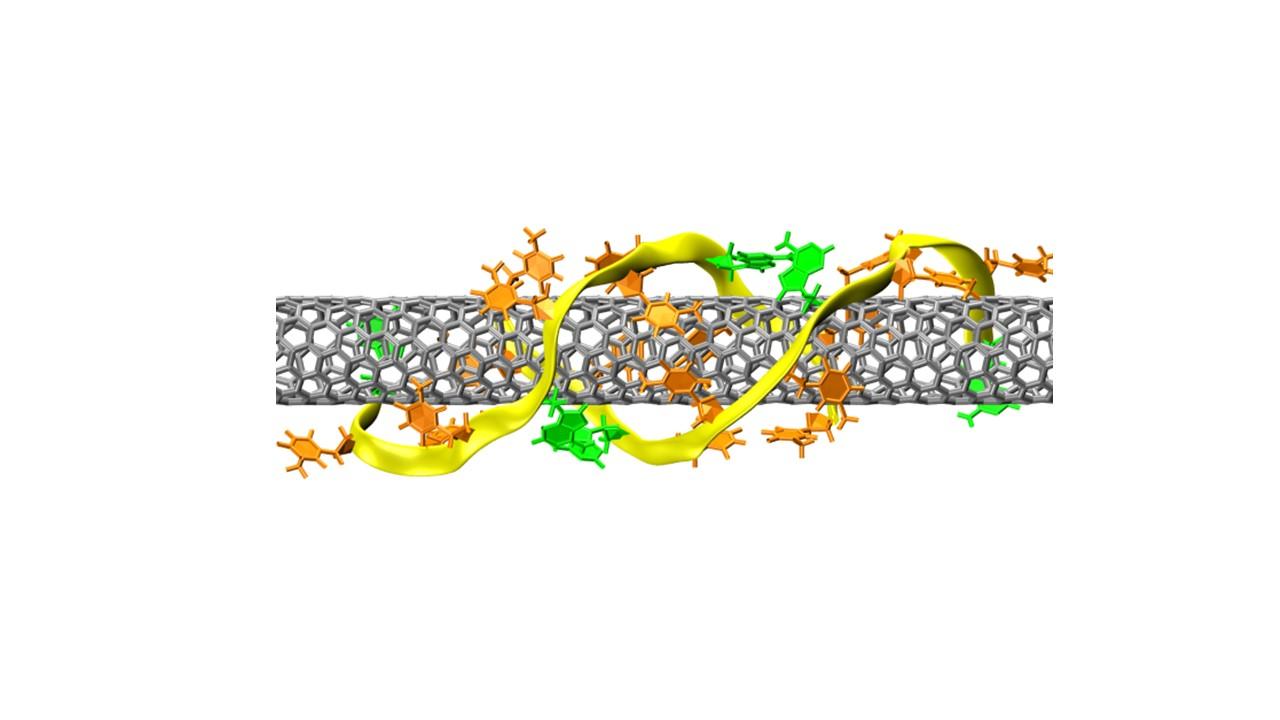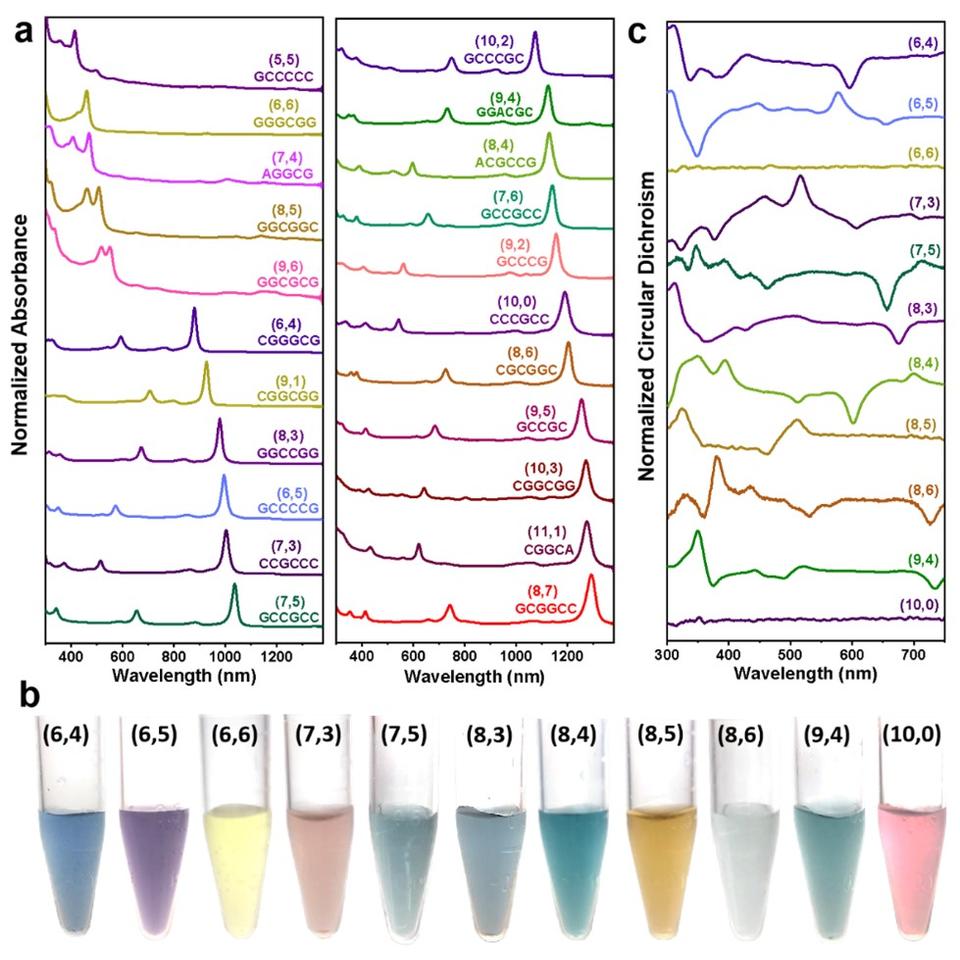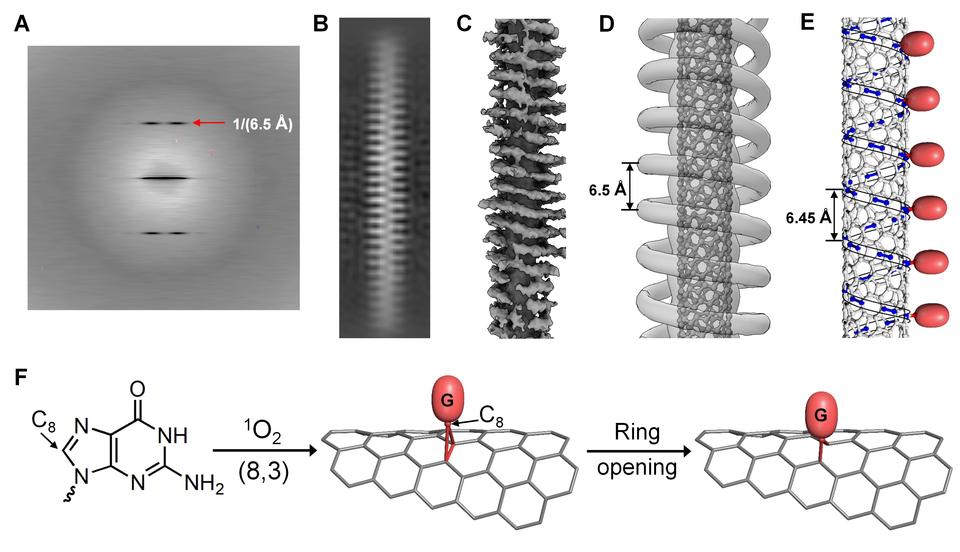Ming Zheng (Fed)
Research Chemist
Research Interests
My research area is at the interface of materials and biochemical sciences. We explore interactions between inorganic nanostructures and biomolecules. We exploit such interactions to create new hybrid structures and functions on one hand, and to discover new biomolecular folding patterns on the other. We investigate empirical and computational ways to solve the sequence selection problem.
Our earlier work has led to the finding of a family of molecular structures: DNA- single wall carbon nanotube (SWCNT) hybrid (see figure below). SWCNTs are one-dimensional molecules that have the same cylindrical shape but different chiralities. Many fundamental studies and technological applications of SWCNT require a population of tubes with identical chirality that current syntheses can not provide. By selecting out ordered DNA-SWCNT hybrids with specific ssDNA sequences, we are able to sort SWCNTs by their chiralities. SWCNT also provides a unique platform to study nucleic acid folding and other biophysical properties. Potential application of DNA/SWCNT interactions ranges from biosensing to programmable assembly of SWCNTs.

Current research topics
- DNA-based SWCNT sorting DNA-based SWCNT sorting offers a powerful tool to obtain pure SWCNTs with defined helicity and handedness across a wide chiral angle range (see figure below for our latest result and ACS Nano 16, 4705, 2022,). A long-term goal of our research is to reveal physical / chemical basis of DNA-based SWCNT sorting, which requires structure information of DNA-SWCNT hybrids and fundamental aspect of colloidal physics involved in the aqueous-two phase extraction. Here lies the opportunity to discover new DNA folding patterns and quantitative description of hydration interactions, both of which are important problems in biophysics.

- Molecular Perceptron Here we aim at developing a universal disease diagnostic approach that makes use of an array of DNA-SWCNTs to measure spectral fingerprint of biofluids and machine learning to classify the data according to physiological states. This approach mimics human perception and is distinct from conventional biomarker-based diagnosis. Our collaborators and us have recently demonstrated this concept in ovarian cancer detection (Nat Biomed Eng. 6, 267, 2022). Future work on rational selection of DNA sequences via standardized training tests should accelerate development of this technology.
- DNA-directed engineering of organic quantum materials. Synthesis of carbon-based quantum materials can, in principle, employ rich organic chemistry to realize novel properties through atomic-precision structural engineering. We have recently show that DNA can be used to remodel the lattice of SWCNTs (see figure below), opening a route to the discovery of 1D organic quantum materials (Science 377, 535, 2022). Future work in this area aims at introducing diversity of functional groups, increasing the coherent length of ordered modification, and spectroscopic probing of new properties emerging from the functionalized SWCNTs.

4. Programmable assembly of SWCNTs SWCNTs are a promising material for future 3D heterogeneous integration of electronics and optoelectronic. A prerequisite for this application is programmable assemble of SWCNTs with nm scale precision. We and our collaborators have demonstrated feasibility of such a bottom-up approach using the DNA brick method and DNA-SWCNT hybrids (see figure below and Science 368, 874, 2020; Science 368, 878, 2020). Future work to simplify the process and to employ AI-generated designer proteins are expected to dramatically improve the efficiency and reliability of SWCNT assembly.


Research Opportunities: Those who are interested in our research are encouraged to apply for postdoctoral positions. For U.S. citizens, the National Research Council Postdoctoral Fellowship with an annual stipend of ~ $80,000 per year is available.
Links: Nanotube Metrology Project
Publications: https://scholar.google.com/citations?user=P2hGlRMAAAAJ&hl=en
Research Blog: "To see life in a drop of blood" ( https://www.nist.gov/blogs/taking-measure/see-life-drop-blood)
Awards
American Cancer Society Postdoctoral Fellow, 1997 – 2000
Chemical Research Council Collaborative Award, 2006
"Nano 50" Inventors Award, 2007
Department of Commerce Silver Medal, 2013


